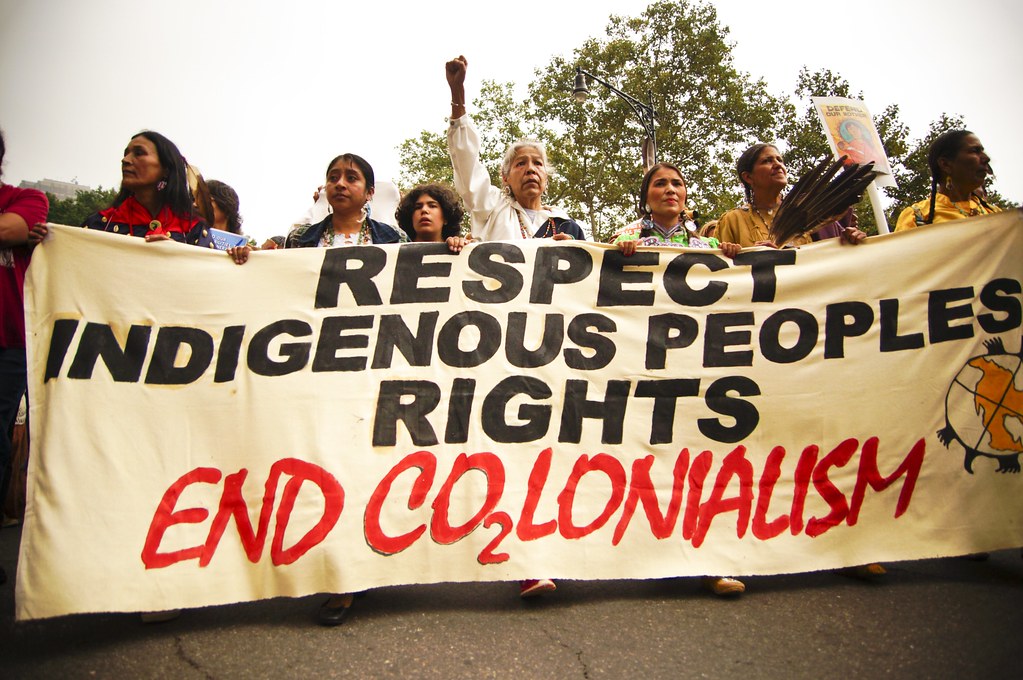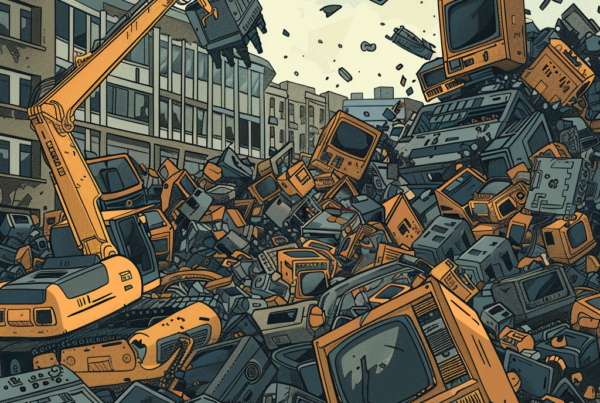Here’s a mind-bender: in the same states where you can’t buy alcohol on Indigenous reservations due to strict regulations, there are zero laws preventing dumping of electronic waste on these same lands.
This bizarre legal loophole has turned many indigenous territories into unofficial graveyards for our digital past.
Remember that old flip phone you had in 2005? There’s a chance it’s sitting in a landfill on Indigenous land right now, slowly leaking toxic chemicals into the soil.
It sounds like the plot of a dystopian novel, but it’s the reality of e-waste disposal in America today.
Table of Contents
- The E-Waste Crisis is a Unique Burden on Indigenous Communities
- How E-Waste Exposure Ravages the Health and Heritage of Indigenous Communities
- What Do We Do About E-Waste in Indigenous Communities
The E-Waste Crisis is a Unique Burden on Indigenous Communities
As production and consumption of electronic devices has continued to skyrocket, electronic waste has become a mounting global concern. In 2022 alone, the world generated a staggering 62 million metric tons of e-waste, and this figure is projected to skyrocket to 74.7 million tons by 2030. Yet, despite the growing awareness of this issue, less than 20% of all e-waste ever reaches a recycling center. Even worse, the rate of e-waste production is rising at a rate that’s five times faster than the growth rate of e-waste recycling. The reality we must sit with is that we are trashing our planet with literal mountains of electronics, and we’re doing it more than ever.
This e-waste crisis is not felt equally across all communities. In the United States, a concerning pattern emerges when we examine the intersection of e-waste disposal and indigenous populations. Only 23 states and the District of Columbia have implemented express landfill or disposal bans on electronic devices. Notably absent from this list are states with some of the highest concentrations of indigenous people, including Nevada, Arizona, New Mexico, Oklahoma, Kansas, North Dakota, South Dakota, Minnesota, Wyoming, Washington, and Alaska. This regulatory gap leaves these communities particularly vulnerable to the negative impacts of improper e-waste disposal.
The e-waste problem, however, is just one facet of a broader pattern of environmental injustice faced by indigenous communities in the United States. More than half of Asian/Pacific Islanders and Indigenous People live in close proximity to uncontrolled toxic waste sites. In California, two of the state’s most heavily used toxic waste landfills are situated near Indigenous reservations. These statistics paint a troubling picture: indigenous people are 1.8 times more likely than any other ethnic group to reside near toxic waste facilities.
This proximity to hazardous sites is not a coincidence. There has been a systematic targeting of reservations for toxic waste disposal, exploiting the economic vulnerabilities of these communities. The environmental burden extends beyond waste sites. Within a 50-mile radius of tribal lands, there are approximately 200 methane and/or coal power plants. Moreover, indigenous people are disproportionately likely to live within half a mile of oil and gas facilities, further compounding their exposure to environmental pollutants.
The consequences of these environmental injustices manifest in stark health disparities within indigenous communities. The diabetes rate among Indigenous People and Alaska Natives stands at an alarming 16.1%, significantly higher than other racial groups. Cancer, too, takes a heavier toll, with indigenous populations experiencing the lowest cancer survival rates of any racial group in the United States. The overall mortality rates paint an even grimmer picture – they are 60% higher for Alaska Natives and twice as high for Indigenous People compared to the general U.S. population.
These health disparities extend across various aspects of wellbeing. The life expectancy for indigenous people is five years shorter than that of other Americans. Respiratory issues are more prevalent, with 13% of indigenous children suffering from asthma, compared to 8.6% of non-indigenous children. The risk of dying from diabetes is 2.5 times higher for indigenous people than for non-Hispanic whites. Heart disease, another leading cause of death, occurs at rates about 50% higher than their white counterparts.
Even in the face of a global pandemic, these health inequities persisted. During the COVID-19 crisis, the mortality rate among indigenous people was 1.8 times that of white people, highlighting the compounded vulnerabilities these communities face.
The convergence of the e-waste crisis with existing environmental injustices and health disparities creates a perfect storm of risk for indigenous communities. As our reliance on electronic devices continues to grow, so too does the urgency to address this issue. The health of our planet and the wellbeing of indigenous communities hang in the balance, demanding immediate and decisive action to curb the flow of e-waste and rectify long-standing environmental inequities.
How E-Waste Exposure Ravages the Health and Heritage of Indigenous Communities
The composition of electronic waste reads like a toxic cocktail designed to wreak havoc on living organisms. Laden with heavy metals and persistent organic pollutants, e-waste poses a grave threat to both human and ecological health. These hazardous materials also, naturally, find insidious pathways into our bodies and environment. Through inhalation, ingestion, and even dermal absorption, these toxins infiltrate our systems. The contamination spreads far beyond the immediate disposal sites, permeating soil, dust, air, water, and even food sources.
While no one is immune to these dangers, certain groups bear a disproportionate burden. Children and pregnant women stand at the forefront of vulnerability, their developing bodies and critical periods of growth leaving them especially susceptible to the ravages of e-waste exposure. The consequences of this exposure are far-reaching, affecting diverse biological systems and organs in ways that can alter the course of a life before it has truly begun.
The developmental impacts of e-waste exposure are particularly heartbreaking. Neonatal growth indices and hormone levels face significant disruption, leading to poor fetal development in early life. The statistics paint a grim picture: reduced birth weight, smaller head circumference, lower body-mass index, and diminished Apgar scores – all indicators of a compromised start to life. But the effects don’t stop at birth. As these children grow, they often exhibit poorer cognitive and language scores, struggling to keep pace with their peers. Many grapple with sensory processing difficulties and behavioral abnormalities, challenges that can persist throughout their lives.
The endocrine system, our body’s delicate hormonal balance, doesn’t escape unscathed. E-waste exposure disrupts thyroid function and alters sex hormone levels, potentially leading to a cascade of health issues. The immune system, our primary defense against disease, also falls victim. Children exposed to e-waste show alteration of proinflammatory cytokines, while adults may experience reduced erythrocyte immunity, leaving them more susceptible to a host of illnesses.
At the cellular level, the damage is equally alarming. Pregnant women and local residents in e-waste exposed areas exhibit telomere aberration, a sign of accelerated cellular aging. Increased micronucleus rates indicate genotoxicity – damage to our very genetic material. Elevated oxidative stress markers further underscore the body’s struggle against these toxic invaders.
The respiratory system bears a heavy burden as well. Children aged 2-8 years living in e-waste exposed areas show accelerated respiratory symptoms and lower lung function levels. The risk of asthma increases, adding to the breathing difficulties already prevalent in many indigenous communities.
Cardiovascular health doesn’t escape the onslaught either. Abnormal measures of cardiovascular physiology become more common, accompanied by vascular inflammation and lipid disorders. Increased heart rate and elevated plasma norepinephrine levels point to a system under constant stress, potentially setting the stage for long-term heart problems.
The list of health effects continues unabated. Children in e-waste exposed areas face an increased risk of hearing loss. Men may experience lower semen quality and DNA damage, potentially affecting fertility. Liver function can become abnormal, and even dental health suffers, with increased dental caries and lower salivary sialic acids observed in exposed children.
Yet, the impact of e-waste extends far beyond individual health, reaching into the environment that sustains entire communities. Native plants, including those used for traditional medicine, food crops, and trees, all fall victim to the pollutants released by improper e-waste disposal. Ground-level ozone, a byproduct of electronic waste, is responsible for up to 90% of air pollution injury to plants. Many crops vital to Indigenous communities are particularly susceptible to this air pollution damage, threatening not just health but also cultural practices and food security.
Indeed, the cultural impacts of e-waste and associated environmental degradation cut deep into the fabric of Indigenous societies. We’re witnessing the erosion of Indigenous cultures and knowledge systems, as traditional practices become untenable in contaminated environments. Climate change, exacerbated by pollution, forces the relocation of entire communities, severing ties to ancestral lands. The inability to practice traditional activities safely impedes the transmission of cultural knowledge to younger generations. Even language faces threat, as the vocabulary surrounding subsistence activities like fishing falls into disuse due to contamination fears.
The pervasive nature of e-waste contamination creates a vicious cycle, where environmental degradation leads to health issues, which in turn undermine the ability of communities to maintain their cultural practices and traditional knowledge. This interconnected web of consequences demands immediate attention and action. As we confront the reality of our digital age’s dark underbelly, we must ask ourselves: what can be done to stem this tide of destruction and preserve the health, environment, and cultural heritage of our most vulnerable communities?
What Do We Do About E-Waste in Indigenous Communities
In the face of the e-waste crisis and its disproportionate impact on indigenous communities, a multi-faceted approach is emerging, combining systemic solutions with individual action. At the forefront of these efforts is the Environmental Protection Agency’s Tribal Waste Management Program, a beacon of hope in addressing the unique challenges faced by indigenous communities.
This comprehensive program offers crucial financial assistance and technical support to tribal communities grappling with waste management challenges. To date, the EPA has awarded 120 grants, totaling around $8.5 million. Impressive as that sum is, it is nowhere near enough. Predictably significant challenges remain in implementing comprehensive e-waste management solutions in indigenous communities.
One of the most pressing issues is the need for improved tribal jurisdiction over waste management. Currently, many tribes lack the legal authority to enforce waste management rules, particularly on “fee lands” owned by non-tribal members within reservation boundaries. This jurisdictional gap makes it difficult to prevent illegal dumping and ensure proper disposal practices.
Infrastructure presents another significant hurdle. Many tribal communities are located in rural or remote areas, lacking the basic infrastructure needed for effective waste management. Unpaved roads, widely dispersed populations, and limited access to recycling facilities all contribute to the challenge. Addressing these issues requires substantial investment in infrastructure development, tailored to the unique needs and geographical constraints of each community.
Financing these initiatives poses yet another challenge. As sovereign nations, many tribal lands do not generate tax revenue in the same way as other municipalities. This necessitates creative financing solutions for waste management programs. Some tribes, like the Saint Regis Mohawk Tribe, have found success through innovative approaches such as blue bag programs, transfer station fees, and contributions from tribal businesses.
In light of lagging action, tribal communities themselves are taking proactive steps to address the e-waste challenge. Many are transitioning away from outdated and harmful practices like open dumps and burn barrels, moving towards more sustainable solutions such as transfer stations. These efforts not only reduce environmental contamination but also create safer, healthier living conditions for community members.
These solutions are noble, but it should not be left to indigenous people to try and piecemeal their health and safety alone. That is why individual action by non-indigenous people plays a vital role in addressing the e-waste crisis on indigenous lands. This is where the power of device donation comes into play. This simple act extends the usable lifespan of our technology, reducing the demand for new device production. In turn, this lessens the strain on natural resources and decreases the overall environmental footprint of the tech industry. Perhaps most importantly, device donation provides vital access to technology for underserved communities, bridging the digital divide and opening doors to educational and economic opportunities.
Beyond individual action, supporting organizations that work on e-waste management and indigenous rights is crucial. These groups often serve as the bridge between policy, community needs, and practical solutions. They play a vital role in advocating for change, implementing programs, and ensuring that the voices of indigenous communities are heard in discussions about e-waste management.
Lastly, we must advocate for stronger e-waste regulations, particularly in states currently lacking such protections, and for indigenous communities to have the final say over what happens with waste on their lands. By pushing for equitable e-waste management policies, we can create a fairer and more sustainable approach to our consumption. This advocacy can take many forms, from contacting local representatives to supporting ballot initiatives that address e-waste and environmental justice. The journey ahead may be long, but with each step taken at both the systemic and personal level, we move closer to a future where technology empowers all communities.






